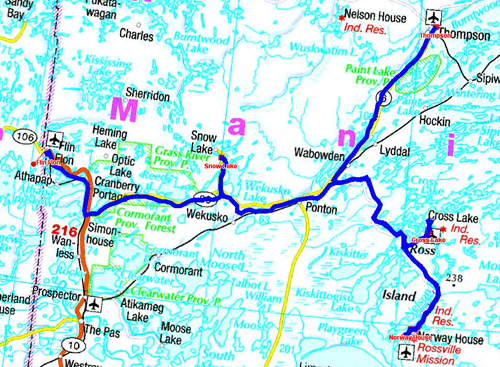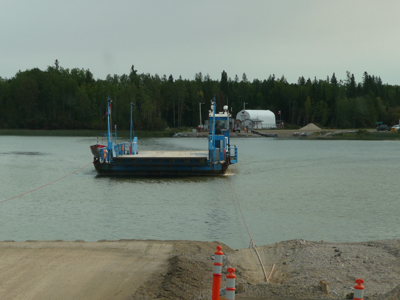En route
On the move towards Norway House I did not
resist the pleasure of seeing again Pisew
Falls under the morning sun without fog.
Hwy #373 to Norway is partly a gravel
road, with a metallic bridge then a free
ferry to cross Nelson River. It operates
the every day 24h /24h until the ice
prevents movement. It is then to replace
by a ice bridge.
 |
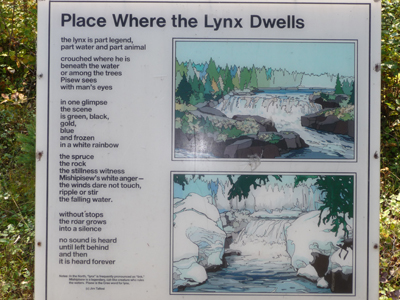 |
| Pisew Falls |
Nelson River country
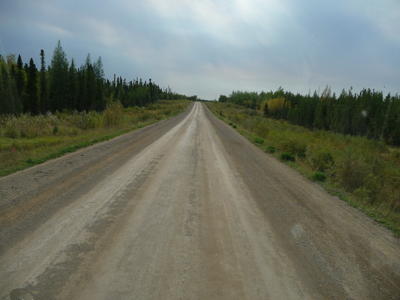 |
 |
| Gravel road |
Norway House
Norway House was at the time of the fur
trade an important crossing point on the
Hayes River towards York Factory on Hudson
Bay. The Norwegian peasants built
buildings for Hudson Bay Compagnie, HBC,
from 1813. Archway warehouse is the oldest
building dating back to 1840/41 remaining
as well as the jail built in 1855. Cargo
were transported by rowing boats, York
Boat, to York Factory. The way was a true
adventure requiring to transport the loads
on the back of men to cross the rapids by
towing the boats on banks. I bivouacked
beside Archway warehouse.
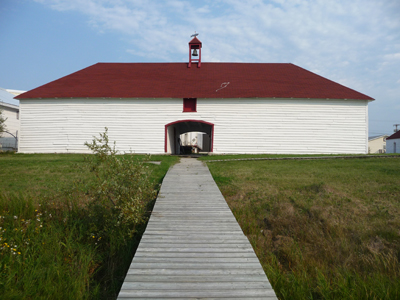 |
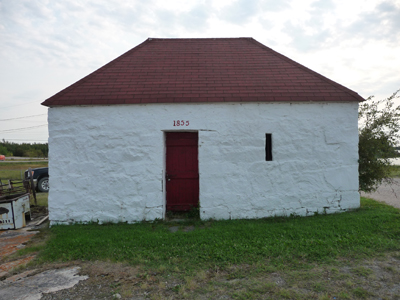 |
| Archway Warehouse |
Jail |
 |
| York boats |
And the "Mounties" came!
Unusual fact in Canada around 9 p.m. three
cars of the Royal Canadian Mounted Police, RCMP,
surrounded my truck with
gyrophares. Typing against the truck body
three policemen with a bad look asked me
for my documents. I believed to dream that
I was in the USA. No, I was well in
Canada. I informed them of my bad mood.
The policemen adopted a tone more
agreeing. Finally at the end of a few
minutes they told me that they did not
have tourists at Norway, I found it hard to
believe. I had been the object of a
denouncement, because the two buildings,
Archway and Jail, were on a private
property. I was to leave on the other side
of the road on the carpark of Fort Island
Arena.
On Tuesday morning I carried out various
controls of my truck. Then around 10 a.m.
on the departure, a car stopped close to
my truck and a man offered two pins and a
ballpoint pen by explaining me with the
delighted look that he knew my
disappointment of the day before. He
belonged to Norway Community Council. I
asked him then if there were a wireless
connection. The answer was negative but he
invited me to the administrative building,
at 30 meters, where he placed a computer
at my disposal. It proved that connection
was very slow, despite everything I sent
two e-mails in 40 minutes. I decided to
remain on the spot for a second night.
Cross Lake
On Wednesday morning before leaving I
returned to the administrative building to
consult my mailbox. I was then interviewed
by a member of the Council on my project
to feed the local gazette with an article
concerning a foreigner visitor if not
strange one. The site of Cross Lake was
inhabited since the remote times by
Nikkikoonas (Otter People). At present the
various islands are connected by causeways
and a bridge since 2002, Kichi-Sipi. The
village is inhabited in majority by First
Nations of Pimikamak Cree Nation
approximately 5600 people. For the summer
period various festivals attract
aboriginal people from the vicinity. I
found a bivouac at the edge of a channel.
Silence and quietude of the place
encouraged me to stay two nights.
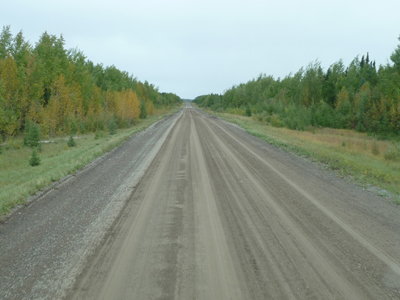 |
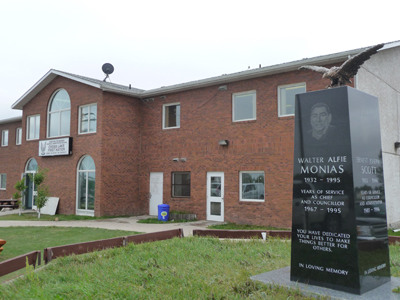 |
| Hwy # 374, route de graviers |
Cross Lake Band Office |
En route Hwy #392
Friday, September 14 was announced radiant
to do lot of mileage up to Snow Lake. Only
attraction on Hwy #392 was Wekusko Falls
and the two suspension bridges, otherwise
nothing.
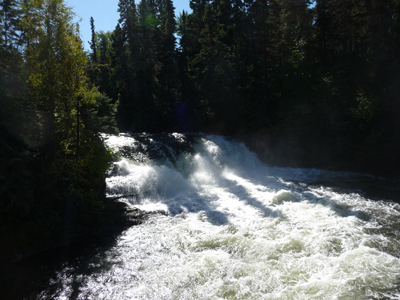 |
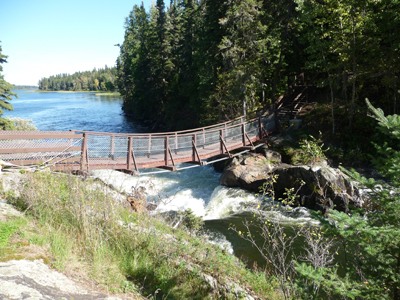 |
| Wekusko Falls |
Suspension Bridge |
Snow Lake
While arriving at Snow Lake I discovered
that Snow Lake Mining Museum was closed
for the season. Moreover the Library was
also closed on Fridays and was opened on
Saturdays from 1 p.m. to 4 p.m. without
outside connection.The rise of the city
was dependant on a tour of layers of gold
in 1927 and with the exploitation by
Hudbay. I found a bivouac at
the entrance of the city on the Public
Boat Launch with the hope not to see again
the RCMP.
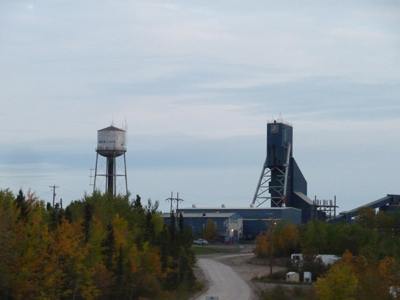 |
| Hudbay Co |
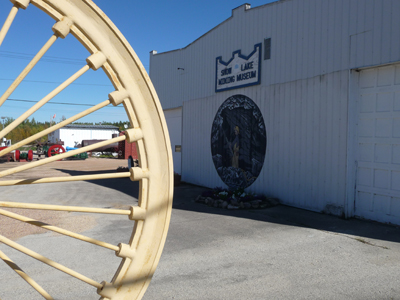 |
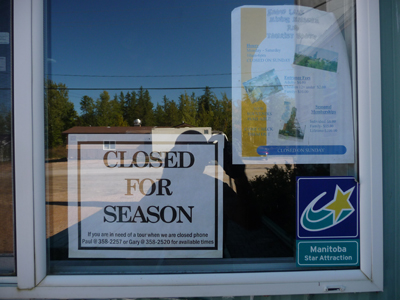 |
| Snow Lake Mining Museum &
Sheave wheel |
Information booth |
Cranberry Portage
Cranberry Portage was created in 1920 at
the edge of the Lake Athapapuskow. It
reached 2000 inhabitants in 1928, terminal
of the railway line. Currently with around
700 inhabitants it is a vacation resort
with Northern Buffalo Sculptures Gallery.
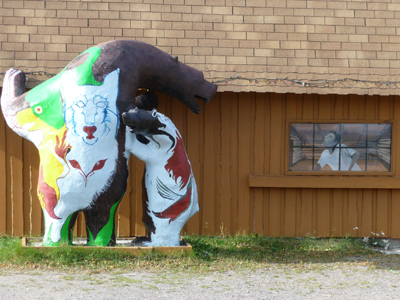 |
| Northern Buffalo Sculpture |
Flin Flon
Flin Flon was named after a character of
the novel “The Sunless City” by Preston
Murdock, Josiah Flintabbatey Flonatin. It
celebrated its 75th birthday in 2010.
Hudbay has exported copper and zinc for
more than 80 years although the copper
smelter was stopped and that the 250-meter
high smoke stack was sealed in 2010.
 |
 |
| Flintabbatey Flonatin |
The 250-metre smoke stack |
